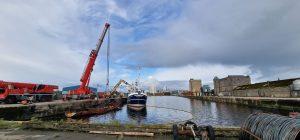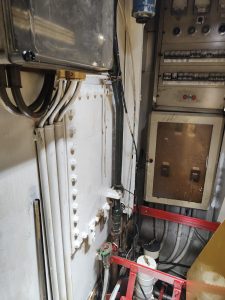CD Environmental completed a 10-month fishing vessel decommissioning project in partnership with UMR, who worked with vessel owners and Bord Iascaigh Mhara. UMR Group are a specialist in Industrial demolition and metal recycling that CD Environmental have worked with on numerous projects. These projects primarily have focused on environment quality and accompanying safety processes.
CD Environmental’s core expertise is managing the decontamination of liquids.
Why were CD Environmental Involved?
CD Environmental were invited to be part of this project by partnering with UMR Group to manage the decontamination of liquids and the associated risk of dealing with hazardous liquids on a dock.
CD Environmental’s role was a complex process of ensuring that all Fuel Streams – diesel, coolant & hydraulic oil – were to a defined process and safely removed and packaged in an environmentally compliant process.
Why did Irish fishing vessels need to be decommissioned?
Bord Iascaigh Mhara confirmed that 57 fishing vessels were looking to exit the Irish fishing industry through the Brexit Voluntary Permanent Cessation Scheme which was proposed under the Seafood Sector Task Force Report published in October 2021.
The purpose of the scheme was to restore balance between fleet capacity and available quotas following the quota reductions arising from the Trade and Cooperation Agreement (TCA), ensuring the profitability of the fleet. The scheme supported vessels in the polyvalent and beam trawl segments to permanently cease all fishing activity, thus increasing the quota available for remaining vessels.
Who was Eligible?
The scheme was open to licence holders of fishing vessels that:
- Are registered on the Irish sea-fishing vessel register in the polyvalent or beam trawl segments and holding a valid sea-fishing vessel license issued by the Licensing Authority for Sea-Fishing vessels at the time the decision was taken to grant the withdrawal premium and which vessels are 10 years or more in age at the time of application, and
- Carried out at least 90 days of fishing activity at sea per year either during 2020 and 2021 or during the calendar years 2018 and 2019.
- Vessels that were granted capacity under the 2001 Lost at Sea Scheme could also apply. However, as the capacity associated with such vessels was non-transferable and could not be sold or traded, applications from the owners of such vessels was be subject to special conditions regarding the level of payment.
The funding for the decommissioning scheme was paid from the Brexit Adjustment Reserve (BAR) awarded by the EU to Ireland. (The sum of almost 1 billion euro must be used up within two years or returned.)
What did Decommissioning of a fishing vessel involve?
Decommissioning a fishing vessel is a process of removing it from service and disposing of it in an environmentally friendly process. UMR Group was CD Environmental’s client.
What was the role of CD Environmental in the project?
CD Environmental primarily carried out the deconstruction process on the water, which included establishing necessary task lighting, locating access points to tanks, stripping pipeworks, emptying tanks and replacing the metal parts when finished. CD Environmental’s responsibility was to ensure this project was carried out in a safe and environmentally compliant approach.
Each vessel was unique, requiring adjustments to the methodology used for deconstruction. Some challenges arose during the project, such as access to tanks which were sealed. One of the unanticipated challenges was accessing these tanks as they had never required access during regular use of the vessel, which proved to be laborious. The resolution was knowing where to create new access points based on the knowledge of our experienced operators.
The hazardous liquids, consisting of diesel, coolant and hydraulic oil, recovered from the tanks, were safely removed and disposed of at licenced facilities by CD Environmental trucks. This process was managed in a controlled and safe process.
For each vessel CD Environmental needed to identify which tank needed to be emptied and established secure access points. In many cases this was complex and involved stripping away pipework which needed to be replaced once the job was completed.
The planning stage of decommissioning was vital and CD Environmental had to take the time to investigate all known options and requirements, ensuring the appropriate cleaning plan and methods were used to keep waste volumes as low as possible. There were several aspects to this project that needed to be considered, and in some case reconsidered including dismantling of the tanks, emptying all liquids – diesel, coolant and hydraulic oil – and thorough cleaning of tanks, so they can be broken down. Each activity needed to be completed in a safe and environmental process.
This was complemented by our team of qualified and skilled operators who analyse every situation independently, to provide customised solutions for each project.
Once all the liquids were drained from the vessel a thorough washdown took place, which involved expert spraying with specialist product the inside of all tanks. This resulted in the breakdown of oils allowing tanks to be easily washed down and cleaned. These cleaned chemical liquids were also taken for environmental disposal.
In summary, the core of the job involved removing all waste, firstly diesel, into CD Environmental ADR Jet Vac trucks and transporting to license facility. Once the diesel was removed the same process took place with hydraulic oil and coolants. The diesel, coolant and hydraulic oil was recycled to avoid costly waste and disposal.
The theory of this job might sound straightforward but the expertise CD Environmental had allowed right decisions of which chemicals to use, how access points were created and also what steps were put in place to manage the worst case ‘what if’.
To date 12 vessels have been safely decommissioned by CD Environmental.
What were the Risk factors in this project?
Due to the high-risk nature of the job, which included pollution to the Shannon estuary, the risk was immense. This would impact flora, fauna and livelihoods. Additionally, this was a very high-profile project. At all times CD Environmental had to consider personnel safety, environmental safety and quality of service delivery. The following were the main risk factors:
- Flammable liquids. There were several liquids involved, diesel, coolant and hydraulic oil. Each of these liquids could create a fire if not handled correctly.
- Cutting pipes around flammable liquids. Sparks had to be contained and managed.
- Confined spaces. Personal safety is always a key factor in confined spaces and correct task lighting was a core requirement.
- Water safety. This project needed to consider buoyancy as the vessels were still on water.
- Speed of delivery. With a 48 hour deadline per vessel, to allow other partners to progress their work, each task within their project had to be planned and timed to perfection.
What were the Resources used in this project?
- Two CD Environmental specialist Jet Vac trucks per vessel.
- Team of professional fitters to strip out engines and tanks.
- Deployed one safety vessel to ensure full visual and monitoring on surrounding waters, and assess booms.
- Specialist equipment including spill kits, absorbent skirt boom, and life jackets
- Supervisor on site
- Marine engineer
What are the lessons learnt by CD Environmental in this project?
Similar to other decommission projects in many ways, however these vessels involved more dismantling to gain access to tanks than most other projects. Additionally, the process in which the engines were stripped need considerable focus on buoyancy and balance. It was a live harbour, with tight deadline and at all times CD Environmental had to have fast reaction times built in should any unplanned changes arise. The possible negative environmental impact was massive, a disaster was always a POSSIBILITY that had to be managed. The control design to ensure spillage would be contained and was minimised was where CD Environmental’s expertise counted.
In short, all tank cleaning projects present consistent challenges, this project had the added complexity of being on the water, and needed a specific plan for this added complexity.
Our foreman, Tom Reynolds, who led the operation, demonstrated exceptional leadership and problem-solving skills, paving the way for a successful 10-month project. We are proud of our team’s accomplishment in completing this challenging project.
We are grateful to the fishermen and vessel owners who entrusted UMR, and indirectly CD Environmental, with their vessels, the final voyage being an emotional day for many. We had the pleasure of meeting and engaging with many fishing families over the course of the project.
CD Environmental matra is SUPERIOR STANDARDS, SERVICE AND SAFETY





